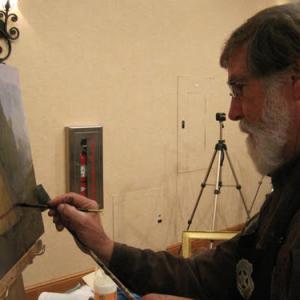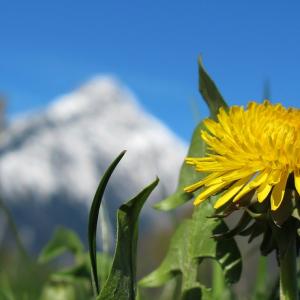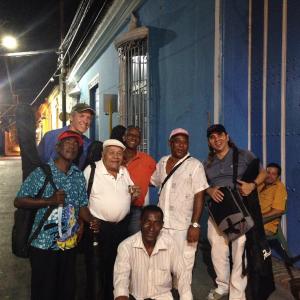R. Tom Gilleon’s art imparts the awareness of what it means to be entitled to peace. In the long, dry draw of the soil, west of Cascade, there is the unconstrained stillness of the contiguous buttes, the almost heroic-looking profile of Mt. Cecelia.
There is the silence of the free terrain where more than a century ago, the shotgun-toting, cigar-smoking former slave “Stagecoach” Mary Fields delivered mail and the Old North Trail, which was followed and zigzagged for thousands of years by Indians. (Ruts of stagecoach wagons mark nearby hills and tipi rings are ever-present.)
There is broad, free daylight outside, with the sun shining, and there is semblance of peace radiating from Gideon’s studio, modern, clean, enveloped by a tarnished coppered façade. The sunlight is really there inside – he has created it through the expression of palettes, colors, and paints, and also drawn from it as a tender intermediary. After all, what else can the artist do but receive the light?
Here, Gilleon, understanding that no artist can grow if they remain closed, is open to new perceptions, new ideas, and new insights. Daily, he ends up fully open to exploratory premises: landscapes; Native American visages of warriors; brilliant contrasts of landmarks and symbols; decorative tipi lodges; the conflicting roles of war and peace in native society; rock faces reflecting glowing sunsets into deep pools; the tipi as a temple, as well as a home. His library study is buttressed by chunky log remnants surviving from a smokehouse dating back to Charles Marion Russell’s (1864-1926) years spent wintering in the neighboring corral.
And the connective thread of Gilleon’s art attaches to the notion that somehow, someway, we can remain connected to the peace of our own pursuits. Gideon adheres to the mantra that imagination is more important than knowledge. “And you can never have enough knowledge,” repeats Tom Gilleon.
Indeed, Gilleon’s art is tied to highly specific and resonant moral and emotional journeys, linked to a Western narrative teeming with aesthetic or atmospheric profundity. It is the duality – the tension between the poetic ideal of the past and the lure of contemporary materialism – that dictates the allure. Gilleon has navigated both worlds successfully, phasing out the successful life of the illustrator for the path of the self-governing. He helped design the look of Epcot Center and then Disneyland Paris, Disneyland Tokyo, and Disneyland Hong Kong. Sometime in the early 1980s, Gilleon and his wife attended an outdoor painting workshop in Montana along the Dearborn River – and it recalibrated his idea of happiness. He moved to Montana, supplementing his income working as a mural painter; one of his jobs was completing matte paintings for the movie “Dick Tracy.” Eventually, the Gilleons purchased a ranch near Great Falls with the rounded profile of buttes expanding in the vastness.
“Back then (when I worked as an illustrator), art was a way to make a good living,” said Gilleon. “These days, I consider myself a craftsman and I’m escaping for that commercialism, gradually. It’s more about communicating something as an artist and working myself into a situation where I can afford to do what I want to do. Creating the freedom.”
As for his resettlement, there were reasons aplenty:
“I had the intelligence of knowing it's beauty when I saw it. When you are able to find a place, it's like knowing it in your heart instantly. It was like no feeling I ever remember. I knew that this was where I needed to be.”
In works such as “Prairie Dare,” Gilleon immortalizes the notoriously fickle and callous weather of the Northern Plains. Constructing anything on the open plains attracts unpredictable fate. Building a tall, narrow grain elevator “is nothing short of a dare,” said Gilleon.
“We are far removed from everything, and out here, you get a good sense of your surroundings and that you are in tune with the feeling that you can die every day out here from something. You could die from the cold easily. Police? You may as well write them a postcard. Fire? We don't have that very close. So, we are not removed from the daily reminder of the life and death experience.”
Tipi paintings are the motif most commonly associated with Gilleon, a coupling of serendipitous origins. In the early 1990s, he was working on retainer as an illustrator for Walt Disney’s “Imagineering Studio,” and he had enough free time to stretch out a blank canvas in front of him. Yielding to his artistic vision, he could not resist experimenting with and endlessly tweaking the scope and extent of the tipi. After he finished it, he took it to a gallery in Ennis, MT., where it sold within days. A couple of hundred tipi paintings later, Gideon said that “when galleries approach me about my work, they always say, ‘We absolutely love your diversity of subject matter, but do you have any tipis?”
Groups of tipi rings can be found within walking distance of Gilleon’s studio, evidence, he said, “of Plains Indian encampments.” He has slept, sketched, and even meditated, inside the tipi rings.
“As far as the type of tipi in a particular place, there were at times several different kinds, and there would be five, six, seven different styles in one village. I try to not just study them, but also keep an open mind.
Born in 1942, he was raised in north Florida by his grandparents in a small town called Starke; his granddad was an accomplished Scottish cabinetmaker, his grandmother a full-bloodied Cherokee. Oil on canvas work such as “Going to the Sun,” Gilleon immortalizes a Blackfeet legend who tells of the Sun God ascending the mountain known as Going to the Sun.
The highest-grossing living artist in the history of the C.M. Russell Museum, Gilleon is grateful that some of his works have fetched “dead man prices,” as Russell referred to them, desirable amounts not ordinarily obtained by even the most talented artists in their own lifetime.
Views of Gilleon’s studio oversee vistas once populated by considerable bison herds, later covered by Lewis and Clark, and, eventually, recorded on canvas by Russell. This humbling, alluring sense of place roots the artist in his sense of mission.
"We've considered going to Tuscany for the summer to go paint. But I wonder, 'why go there when I have this?' When I have all of this it would be hard to be away from here for even 10 days. It's gotten harder to make that trade-off. Think about a painter in Southern France, and as beautiful as it is there, imagine if that painter were to leave some village and come to Montana, to visit Little Big Horn, to come paint here. The grass is always greener, right?"
Similar to other artists, Gilleon must go through the kinetic process of self-emptying in order to become and stay hale and hearty. His art is physical, mental and even technological: he illustrates models on the computer and then hand-paints on canvas.
“Digital art is fast, but the easel takes several weeks, for several weeks the easel stays in your mind. Technology is one thing. But the ancient art of painting is something else. The tactility of the paint on the canvas and the feel of the canvas – that’s the best feeling.”
Art is also the ability to seize the moment and live a life without regrets. It is also a feat of grit and endurance and, in Gilleon’s estimate, the absolute act of reaching far back deeply into the wonder of childhood.
“Kids don’t make mistakes in art,” said Gilleon. “Everything is right. A good piece of advice would be, ‘Work as hard for the next 75 years to be as good as you were when you were four.”
Rooted in the fundamental energy of a creativity that has forever been underlying his existence, Gilleon plots his next idea.
In becoming more conscious of the full range of his thoughts and feelings, he inevitably has become less threatened by the knowledge of his flaws and can now more readily integrate and appreciate the whole of who he is.
When he acknowledges his imperfections, he finds himself in a better position to work on those areas within his power to change and to accept those things he cannot.
“Art, as they say, is the pursuit of imperfection,” said Gideon.
 Brian D'Ambrosio is a writer/editor living in Missoula, Montana. D'Ambrosio is the author of more than 300 articles and five books related to Montana history, people, and travel.
Brian D'Ambrosio is a writer/editor living in Missoula, Montana. D'Ambrosio is the author of more than 300 articles and five books related to Montana history, people, and travel.




 Brian D'Ambrosio is a writer/editor living in Missoula, Montana. D'Ambrosio is the author of more than 300 articles and five books related to Montana history, people, and travel.
Brian D'Ambrosio is a writer/editor living in Missoula, Montana. D'Ambrosio is the author of more than 300 articles and five books related to Montana history, people, and travel.




